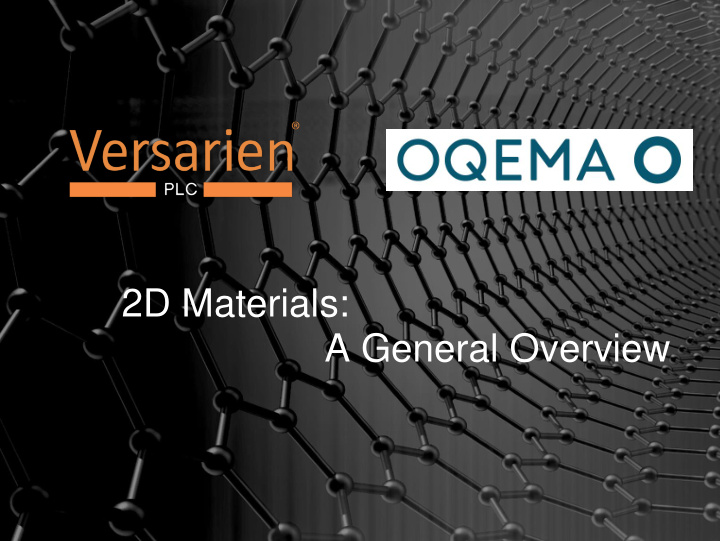



2D Materials: A General Overview
A specialty and commodity chemical distributor operating out of Asia, Europe, America and the Middle East. We provide services along the supply chains: ranging from the procurement, product development and individual mixing to logistics and recycling. One of the top 10 distributors in Europe
Group Structure
Versarien 2D products Two scalable and patented manufacturing processes • Nanene - high quality few-layer graphene nano-platelets with low defect ratio and large lateral dimensions - Mechanical Chemical Exfoliation • Graphene inks - Micro-fluidisation Also available • Few Layer Boron Nitride • Graphene oxide • Reduced graphene oxide
Overview of Graphene … . • 2004: Isolated by Geim & Novoselov • 2010: Geim & Novoselov awarded Nobel Prize or Physics • 2005-2014: 25,000 patents registered representing 13,000 patent families • Graphene patents by number: 1st China; 2 nd Korea; 3 rd US; 4 th Japan; 5 th Taiwan. However, note that the majority of China patents cover only China.
GRAPHENE - BASIC PROPERTIES Graphene shows a unique combination of properties which can be exploited to enhance existing systems, or facilitate multi-functional materials. Properties include: • High strength • Flexibility • Semi-Transparency • Electrical conductivity in the X-Y plane • Thermal conductivity • Barrier to Gas Permeation • Bio-Compatibility
The future … Graphene enabled … Smart materials and textiles Stronger and lighter materials e.g. carbon fibre reinforced plastics Superior batteries and supercapacitors Flexible electronics inc. sensors Faster electrical components Superior radio frequency antennas – novel format and construction Optoelectronics Inc. Lasers Anti-static polymer systems and coatings Anti-corrosion coatings Strength - Thermal - Electronics
POLYMER COMPOSITES Addition of graphene can improve mechanical performance, electrical and thermal conductivity of polymers and polymer composites Major EU composites project (NANOMASTER) included partners LEGO, Phillips Consumer Electronics and Rochling (auto components) Applications include: • Sports goods: HEAD tennis racquet has shown reduced weight and improved stiffness and performance. • Aerospace: Electrically conductive resin systems have shown potential for anti-static composite systems, and also for electrical resistance heating for anti-icing. • Automotive: Composite suspension components, car body composites, heater membranes, anti-static tyres
BARRIER Graphene is a barrier to gas diffusion, including Helium Applications include: • Additives to improve surface coatings such as anti-rust and paints for corrosion protection • Moisture barrier paints for buildings • Food packaging – barrier to water and oxygen to improve shelf life
FILTRATION Graphene Oxide has selective barrier properties, applications include: • Water filtration membranes. Separation of organic solvent from water • Removal of water from a gas • University of Manchester have developed a graphene – oxide membrane with tunable pore sizes for desalination of sea water. • Organic solvent nanofiltration (OSN). University of Manchester have also demonstrated that OSN can selectively remove other species, such as separating organic solvents. Examples include removing colour dye from methanol, molecules from organic solvents for e.g. pharmaceuticals; filtering whiskey allowed alcohol to pass through but filtered out the larger molecules which produce the brown colouration.
ENERGY STORAGE High surface area and electrical properties of graphene open up new opportunities in batteries and supercapacitors Applications include: • Extending the life of Li-Ion batteries • Reducing battery charge time • Reducing battery size and weight – e.g. for wearable electronics
BATTERIES Huawei announced results for graphene-assisted Li-ion batteries. Main effect has been improved thermal management – e.g. ability to operate battery at higher temperatures • Charging 3,000mAh battery to 48% in five minutes • Extended life – 70% capacity remaining after 2000 cycles at 60degC • Mobile phone battery due to be launched Dec 2018
FUEL CELLS • Modelling at Rice University USA indicates that graphene could replace platinum in fuel cells • Work at Berkeley Lab USA on Graphene-encapsulated magnesium nanocrystals for hydrogen storage, overcomes problems in metal hydrides by increased rate of absorption and desorption
BIOMEDICAL Graphene is being investigated for opportunities in medicine Applications include: • Targeted drug delivery • Diagnostic kits and sensors e.g. blood sugar level kits • Retinal prostheses (i.e. graphene contact lens)
ELECTRONICS & SENSORS Graphene particulate can be formulated into inks for printing of circuits and devices Applications include: • Printed conductive tracks and circuits • Printed sensors • Printed antennas e.g. RFID
Graphene Inks ● Graphene printed sensors, e.g. strain sensors
WEARABLE ELECTRONICS Applications under development include: • ‘Smart skin’ tattoos • Battery-free healthcare & fitness monitoring Credit: University of Manchester
PRINTED ELECTRONICS • RFID printed graphene tags & tickets for security, tags for food and consumer stores for real-time stock control & anti-theft • Conductive printed graphene electrodes on e.g. paper
DISPLAYS • Work at TU Delft discovered interference effect between graphene layers which produced colour changes under loading. This effect is being developed into pixels for colour displays Image Credit: TU Delft/Graphene
Thank you for your time! Lewis Chard
Recommend
More recommend